The Bala shark, also known as the tricolor shark or silver shark, is a freshwater fish species that is popular among aquarium enthusiasts. Aquarists value the fish for its size, likeness to a shark, aggregative behavior, and ability to live together with any tank mates of a similar temper and size. However, bala sharks actually aren’t sharks and have nothing in common with them. Tricolor shark belongs to the family Cyprinidae, which includes carps and minnows.
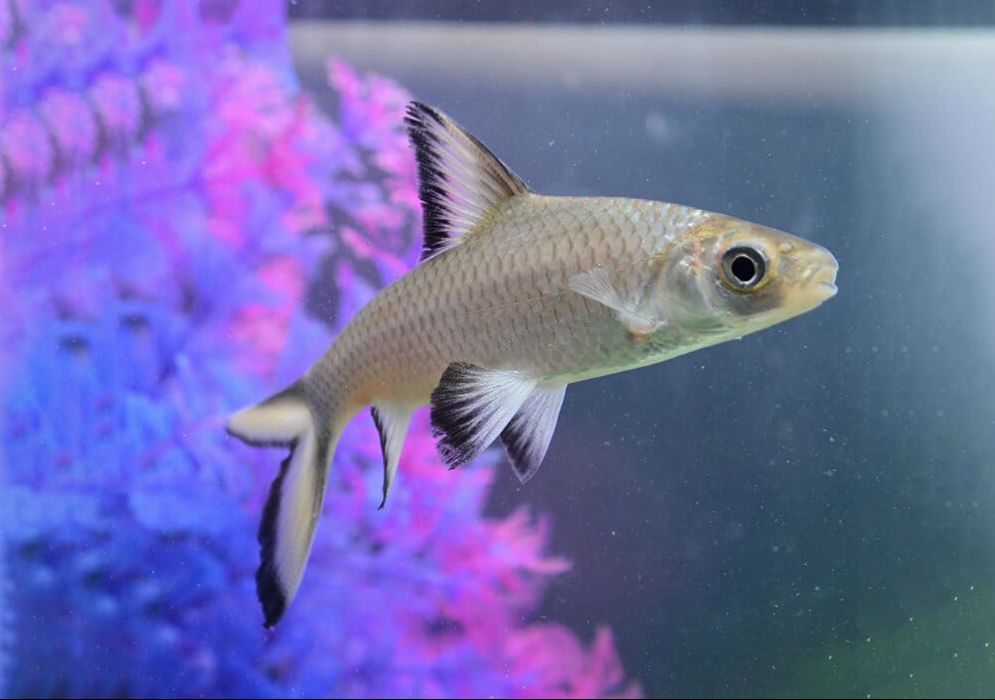
Contents
Habitat in the wild
Bala shark (lat. Balantiocheilos melanopterus) is a tropical freshwater fish belonging to the Cyprinidae family.
The name Balantiocheilos originates from two Greek words: balantion – a sack, a cavity; cheilos – a lip. Bala shark was described by Pieter Bleeker in 1851 for the first time. The Dutch doctor and ichthyologist suggested that the fish is from the Mekong river basin in Thailand, but later the scientists proved that he was wrong.
The bala shark is native to Thailand, Borneo, and Sumatra. Earlier it was considered that its habitat is in the Mekong and Chao Phraya river basins, but nowadays, this information is considered wrong.
The fish prefers clean rivers and streams with fast water flow since slow flows are not for it. Sadly, bala shark has become extinct in lots of its natural habitats. Bala sharks are found in slow-moving rivers and calm, freshwater lakes. They inhabit areas with dense vegetation, submerged logs, and rocky structures. Their natural habitat often includes areas with dense aquatic vegetation, such as floating plants, submerged plants, and marginal plants. These provide cover, hiding places, and natural food sources.
Bala sharks are social fish and tend to form small groups in the wild. They are often observed swimming together in schools, which provides them a sense of security and improves their overall well-being.
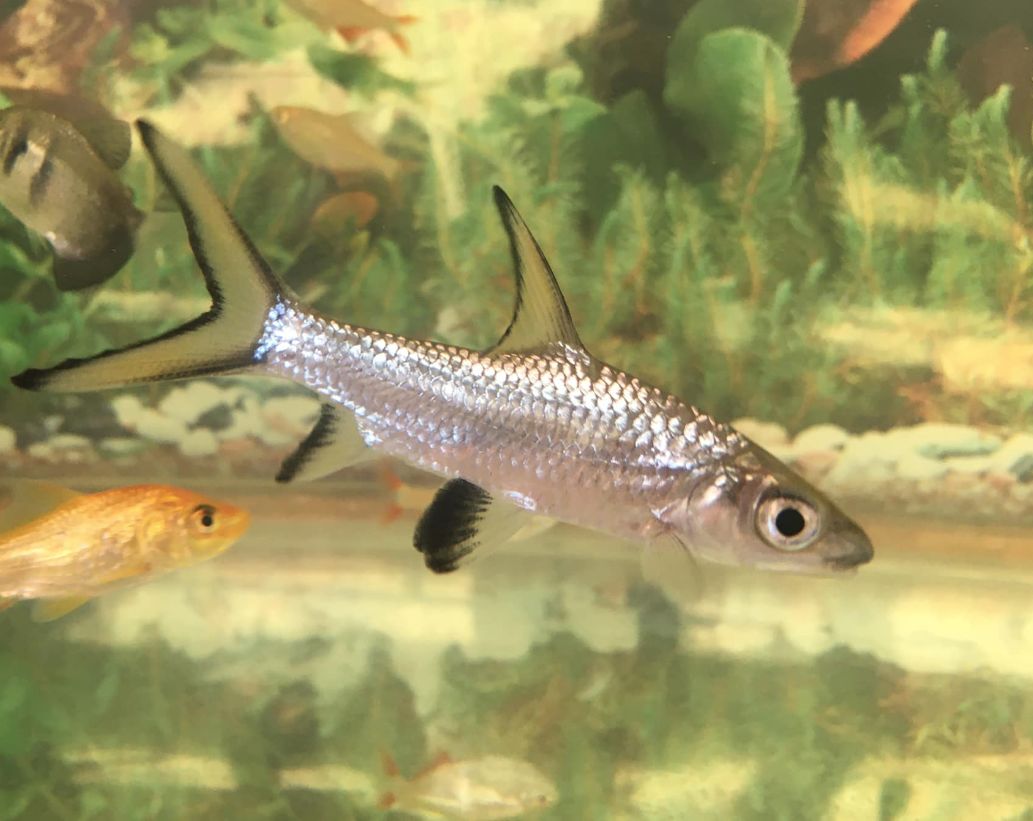
Description
The silver shark body is thin and slender, flattened from sides. Bala sharks have a streamlined, torpedo-shaped body. Their body is elongated and slightly compressed laterally. The head is small, the eyes are very large, and the fish has an inferior mouth with no barbs.
The scales are very large, and the fins are sickle-shaped. The dorsal is tall and vertical, and its fluke is bifurcated. The body is silver steel-colored, large scales create sparkles, giving it a sleek and metallic appearance. The silver coloration reflects light and enhances its visual appeal.
Size
How big do bala sharks get?
In pet shops, as a rule, you see the fish about 5 cm long (2 in). But don’t be fooled with this small size because these are just juveniles. In the wild, this fish can grow to become 40 cm long (16 in). Some reports suggest that exceptionally large individuals may even grow up to 18 inches (45 cm) or slightly more. However, in captivity, they are often smaller, typically around 10-12 inches (25-30 cm).
It’s important to consider the potential adult size of Bala sharks when planning to keep them as pets. Since the fish is quite large, it requires a spacious tank. If the tank is not spacious enough for the fish, the lifespan will be much shorter than it should, and the fish will feel uncomfortable all the time.
Growth rate
How fast do bala sharks grow?
Bala sharks have the potential to grow relatively quickly, especially when provided with optimal conditions. Factors such as water quality, diet, tank size, and genetics can influence their growth rate. However, it’s important to note that the growth rate can vary among individuals.
In their first year of life, Bala sharks can experience significant growth. It’s not uncommon for them to grow several inches during this time. However, as they mature, their growth rate tends to slow down.
In ideal conditions, with ample space, good water quality, and a balanced diet, Bala sharks can reach sizes of around 10-12 inches (25-30 cm) within the first couple of years. After that, their growth rate may slow down, and they may continue to grow at a slower pace.
Lifespan
How long do bala sharks live?
The average lifespan of a tricolor shark can vary depending on various factors, including the quality of care, diet, water conditions, and genetics. In general, Bala sharks have the potential to live for a relatively long time compared to some other aquarium fish species. On average, they can live for about 8 to 15 years in captivity, although some individuals may live longer with proper care. Keep in mind that individual lifespans can still vary, and some Bala sharks may have shorter or longer lifespans depending on various factors.
| Characteristic | Description |
|---|---|
| Scientific Name | Balantiocheilos melanopterus |
| Common Names | Bala shark, tricolor shark, silver shark |
| Family | Cyprinidae (carps and minnows) |
| Habitat | Freshwater rivers and lakes in Southeast Asia |
| Appearance | Silver body with a black horizontal band |
| Size | Up to 14-16 inches (35-40 cm) in the wild, smaller in captivity |
| Tank Size Requirement | Minimum of 75 gallons (284 liters) |
| Water Temperature | 75-82°F (24-28°C) |
| pH Level | Slightly acidic to neutral (around 6.5-7.5) |
| Diet | Omnivorous, primarily herbivorous |
| Behavior | Peaceful, but can become territorial with age |
| Compatibility | Best kept in small groups, avoid small fish as tankmates |
| Breeding | Challenging and rare in captivity |
| Conservation Status | Not considered endangered or extinct (as of September 2021) |
Difficulties in keeping
The bala shark is not a demanding one, but the thing is that it should be kept in a school, and the fish grows to become a large one. To keep the school of 6 species, you’ll need a very large tank, not less than 150 cm (5 ft) long. This species is quite enduring and lives long provided with proper care. It is easy to feed since it eats all kinds of food. It grows big and rather fast. Thus it becomes too large for its tank very quickly.
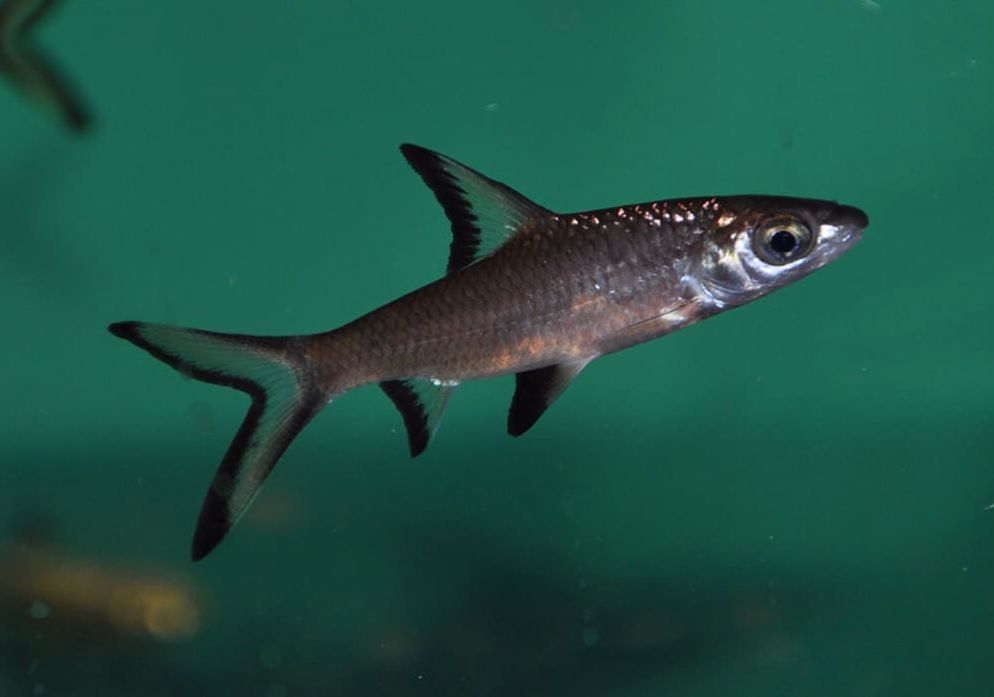
Keeping in a tank
Bala shark is prone to get stressed: when getting very scared, it may even die. After buying the fish, be ready – it’ll behave rather nervously.
The fish may refuse food and hide. This happens because the fish is usually brought right from its natural habitat, i.e., from real open waters. Therefore, when getting into a tank, the bala shark gets stressed and starts looking for a place to hide.
Keep this in mind and create in advance some hide-places, allowing the bala shark to adapt to new life conditions and survive relocation. You can improve the appetite of the fish which refuses from food by active water renew (up to 30-40% every day) and by raising the tank water temperature 2-3 degrees.
Some time later, when the fish gets stronger and starts hungrily eating their food, you can decrease the water temperature back to normal value and then reduce the number of water renews to the ordinary schedule.
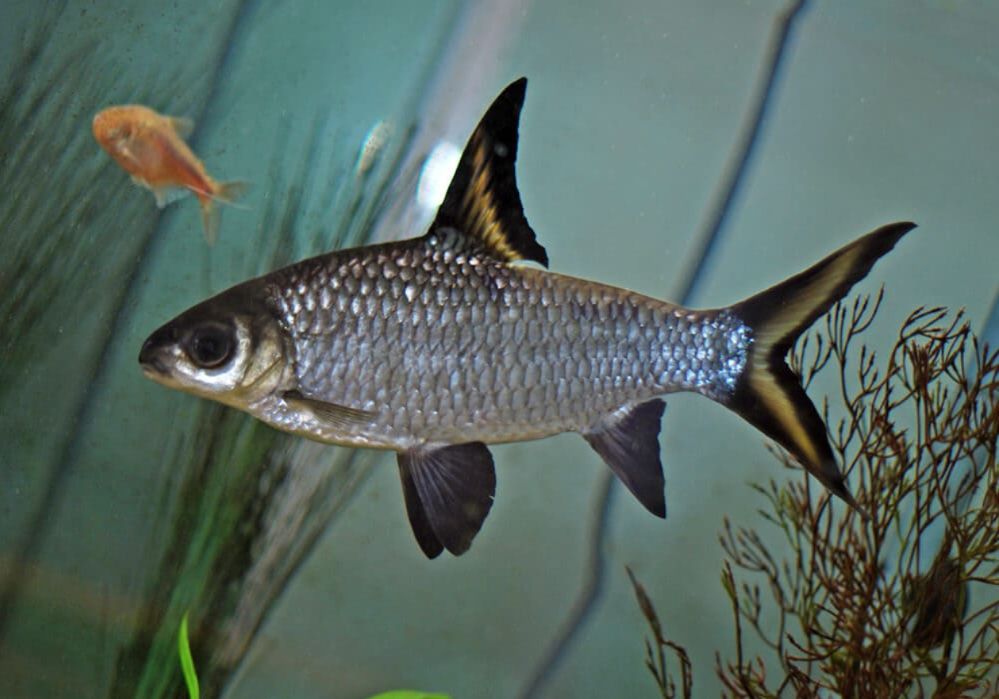
Tank size
The main thing for bala shark is a sufficient amount of tank space. The large size completely corresponds to its high activity. Plus, the fish should be kept in a school of 6 species at least. It mustn’t be kept alone or just a couple. There must be at least 5 species in a school; otherwise, dominant species will show aggression towards weaker relatives or other tank mates. A very small school can also cause the fish to get nervous or sick.
The tank has to be rather wide and not less than 150 cm (5 ft) long. For juveniles, the tank capacity should be at least 200 liters (52,83 gal), but the advisable tank size, in this case, is around 75 gallons (284 liters) or larger. However, providing an even larger tank is preferable if possible, as it allows the Bala sharks more room to swim and reduces potential stress.
Representatives of this fish kind fancy spacious tanks a lot; thus, it should be not just a large one, but also wide enough, providing enough space for them to swim.
The tank must be closed from the top: fish excessive activity or fright may lead to the fish jump out of the tank and death as a result. Bala sharks are very timid (especially in the beginning) and active that’s why they often jump out of the tank if it is not covered from the top.
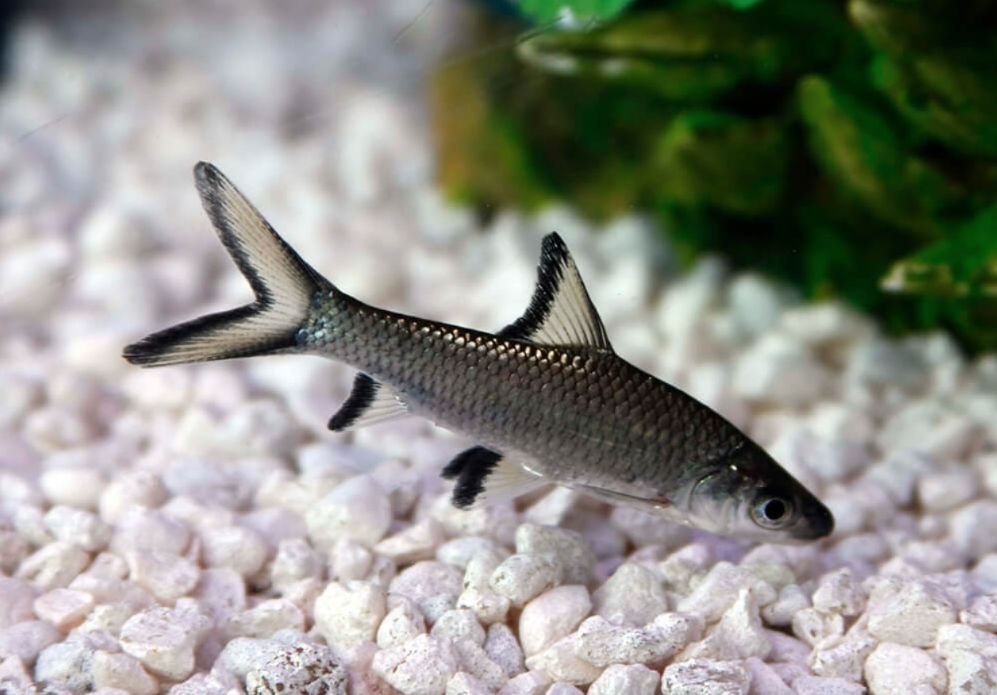
Water parameters
Here are the recommended water parameters for Bala sharks:
- Temperature: Bala sharks prefer a water temperature between 75-82°F (24-28°C). It’s essential to maintain a stable and consistent temperature within this range.
- pH Level: Bala sharks thrive in slightly acidic to neutral water conditions. The recommended pH range for Bala sharks is typically between 6.5-7.5.
- Hardness: Bala sharks are adaptable to a moderate range of water hardness. A general guideline is to maintain a hardness level between 5-15 dGH (degrees of general hardness).
- Ammonia, Nitrite, and Nitrate: It’s crucial to ensure that the levels of ammonia and nitrite are consistently at zero, as these substances are toxic to fish. Regular water testing and proper filtration are necessary to maintain good water quality. Nitrate levels should also be kept under control, ideally below 20-40 ppm (parts per million).
- Water Quality and Filtration: Bala sharks require clean and well-filtered water. Adequate filtration, including mechanical, biological, and chemical filtration, is essential to remove waste and maintain water quality.
Regular monitoring of water parameters is necessary to ensure they remain within the appropriate range. Performing regular water changes, typically around 25% of the tank volume every 1-2 weeks, helps maintain optimal water quality.
Tank setup: decorations and plants
As for the tank decorations – don’t put too many decorations and plants. You can use some stones and snags, but again, not too many. The fish requires a lot of space to swim, so it’s better to put tank decorations along the tank perimeter.
Choose tank plants with thick leaves and a strong root system – soft-leaved plants will be attacked and harmed by the fish. As for the tank bottom substrate color, it’s better to be dark: on such a background, the fish will look much better.
Fish prefers natural light. For the fish, the light day is 8-10 hours.
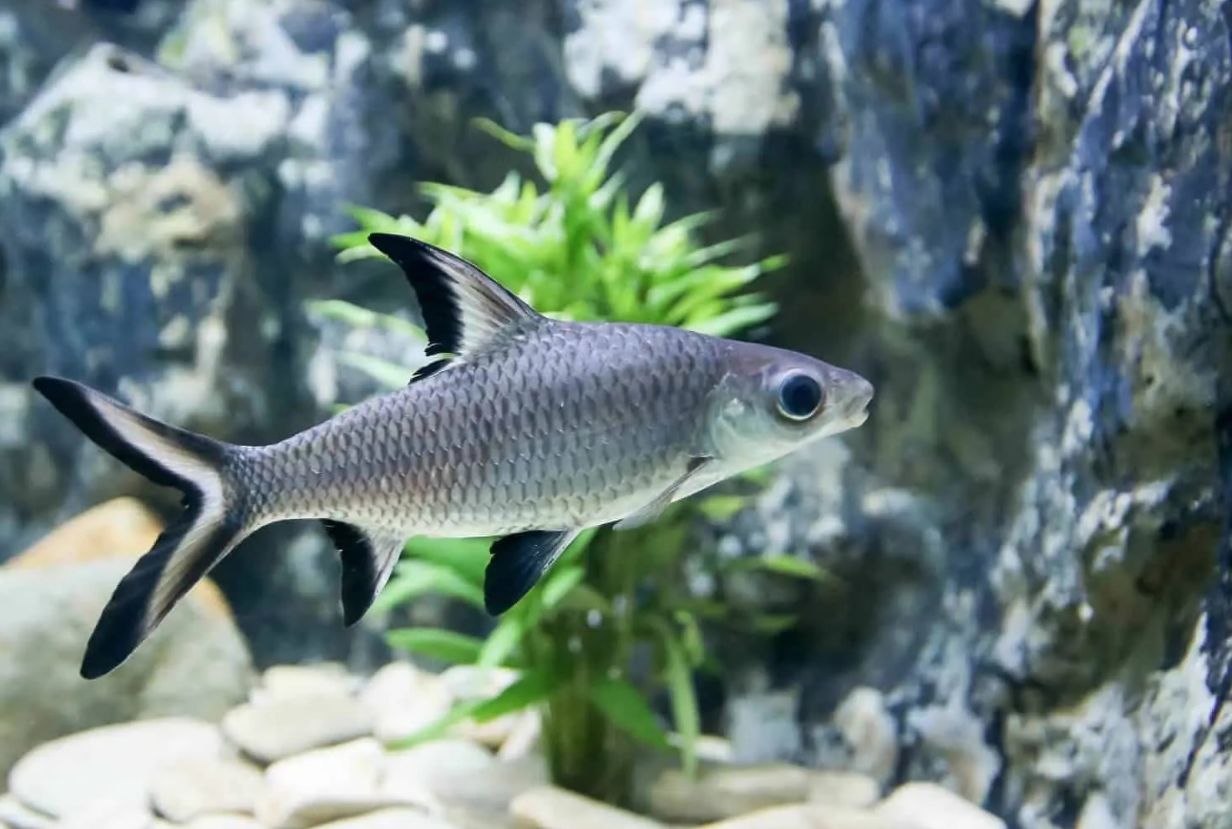
Filtration
In the wild, bala shark inhabits clean waters. That’s why when keeping it in a tank, you’ll require a perfect filtration system creating sufficient water flow and good aeration. Considering that the fish is large and schooling one, the only option is to use a powerful canister filter.
Diet
The wild bala shark diet is rather diversified: worms, maggots, pieces of plants, algae. Like most Cyprinidae species, they are very gluttonous and are constantly looking for food.
Despite their good appetite, bala sharks are rather sensitive to the food quality. It’s not recommended to feed with a blood worm since the stomach may fail to digest its chitinous shell. As a result, the whole digestive system may suffer. You should keep in mind that live food is dangerous because it may infect the fish with various diseases and parasites.
For proper growth and development of the bala shark, you must select high-quality artificial food for them. It is convenient to use and store; it is safe and well-balanced. Choose high-quality commercial fish foods specifically formulated for tropical fish or herbivorous/omnivorous species. Look for products that contain a blend of plant-based ingredients, proteins, and essential nutrients. You can find flake or pellet foods designed for herbivorous fish or general tropical fish.
Plant food additives are quite necessary for the proper diet. Up to 10% of the daily diet must be plant food. Often lettuce and spinach leaves are used for this purpose. However, if you leave them in the tank for a long time, they may reduce the water quality. It’s better to use food with high spirulina content for this purpose. You can offer them blanched vegetables such as spinach, lettuce, zucchini, or peas. These can be chopped into small pieces and provided as occasional treats.
Bala shark takes the food in the middle water layer; it eats food from the tank bottom less enthusiastically. Pellets quickly get soft and go slowly to the tank bottom, and this makes them perfect for the fish feeding in the middle tank layers.
To keep the bala shark healthy, you should control its diet and don’t feed it with the same kind of food all the time. Bala shark is very gluttonous, so sometimes you should arrange some hungry days for it. It is better to feed them 2-3 times a day with the food portion that will be eaten in several munites completely.
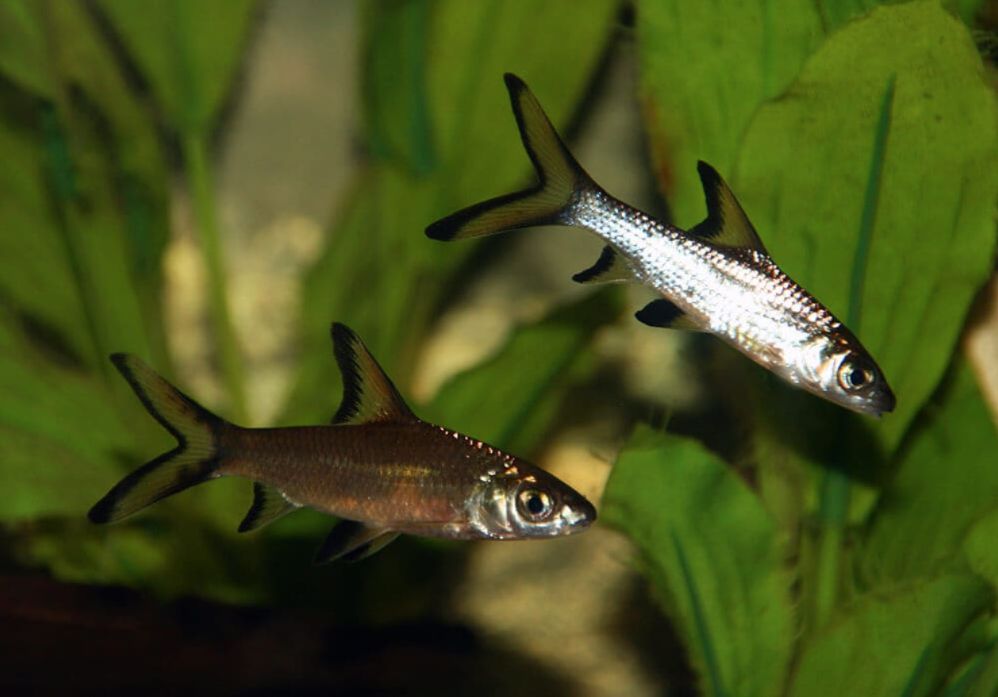
Tank mates
Bala shark is a peaceful daytime fish. It is rather tolerant to its tank mates. However, when choosing tank mates focus on your tank size since it has to stay spacious enough for all fishes and shouldn’t be overcrowded. Bala shark is quite good for large community tanks since it doesn’t deal with sufficiently larger fish. It is a rather timid fish, but it is fast, and it’s a good jumper. That’s why you should be careful when cleaning the tank bottom or catching the fish in the tank.
As we’ve already mentioned, large and small fishes can be tank mates. Just avoid very small fishes, juveniles, large cichlid species like Jack Dempsey or oscar fish (large predators may nip fins), territory dependent, and slow fishes.
Here are some examples of potential tank mates for Bala sharks:
- Larger Tetras: Some larger tetra species like Congo tetras (Phenacogrammus interruptus) or Buenos Aires tetras (Hyphessobrycon anisitsi) can be compatible with Bala sharks. These tetras are active and can tolerate similar water conditions.
- Gouramis: Peaceful gourami species like the Pearl gourami (Trichogaster leeri) or the Opaline gourami (Trichopodus microlepis) can make good tank mates. They have a similar temperament and can tolerate similar water parameters.
- Barbs: Certain barb species, such as the Rosy barb (Puntius conchonius) or the Tinfoil barb (Barbonymus schwanenfeldii), can coexist with Bala sharks. It’s important to choose larger barb species that are not prone to nipping fins.
- Rainbowfish: Some larger rainbowfish species like the Boeseman’s rainbowfish (Melanotaenia boesemani) can be compatible tank mates. They share similar water requirements and add vibrant colors to the aquarium.
- Other Large, Peaceful Fish: Certain peaceful, larger fish like giant danios (Devario aequipinnatus), clown loaches (Chromobotia macracanthus), or silver dollars (Metynnis spp.) can potentially coexist with Bala sharks. However, it’s crucial to ensure that the tank is large enough to accommodate the potential size and swimming needs of all the fish.
Do bala sharks eat other fish?
Yes. Always keep in mind adult fish size: though the fish isn’t a predator itself, it may eat its small tank mates. In general, Bala sharks can coexist peacefully with other fish species that are of similar size or larger and have peaceful temperaments. That’s why it’s not a good idea to keep bala shark together with a betta, mollies, guppies, neon tetra, harlequin rasbora, and other small creatures like cherry shrimp.
How many bala sharks should be kept together?
Bala sharks are social fish that generally do best when kept in groups. Keeping them in a group helps reduce aggression and stress, and it mimics their natural behavior in the wild. The recommended number of Bala sharks to keep together is a minimum of five individuals. It prefers to live in a school of 5-7 species, but if the tank size doesn’t allow to keep such a large school, try to keep at least 2-3 species – if the fish is alone in the tank quite often, it’s aggressive.
By keeping a group of at least five Bala sharks, you provide them with a more natural social dynamic, allowing them to establish a hierarchy and interact with each other. It also helps distribute any aggression among the group, reducing the chances of a single fish being targeted excessively.
Additionally, when kept in a group, Bala sharks tend to exhibit more natural and active behaviors, which can enhance their overall well-being. Seeing them swim together in a school can be visually appealing and enjoyable.
However, it’s important to note that keeping a larger group or overcrowding the tank can lead to stress, competition for resources, and potential aggression. Therefore, it’s crucial to provide an adequately sized tank that can accommodate the needs and potential growth of multiple Bala sharks.
Can bala sharks live with goldfish?
It is generally not recommended to keep Bala sharks with goldfish due to their different requirements and potential compatibility issues. Goldfish shouldn’t be kept in one tank with bala shark, since it is too slow, likes colder water, and they have poor compatibility.
Bala sharks prefer warmer water temperatures ranging from 75-82°F (24-28°C) as they are native to Southeast Asia. Goldfish, on the other hand, are coldwater fish and thrive in temperatures around 65-75°F (18-24°C).
Bala sharks can grow quite large, reaching lengths of up to 14-16 inches (35-40 cm) in the wild. Goldfish also have the potential to grow quite large, depending on the variety. However, goldfish tend to have a slower growth rate compared to Bala sharks. The significant size difference between the two species can lead to compatibility issues, including the potential for the Bala shark to view the goldfish as prey or for the goldfish to be stressed or injured by the more active Bala sharks.
Bala sharks are primarily herbivorous, while goldfish are omnivorous. Their dietary requirements and preferences differ, and meeting the nutritional needs of both species can be challenging. Bala sharks may benefit from a diet rich in plant matter, while goldfish typically require a balanced diet that includes both plant matter and protein-based foods.
Can bala sharks live with angelfish?
It is generally recommended to avoid keeping Bala sharks and angelfish together in the same aquarium, particularly as both species grow larger. Their different size, water temperature preferences, potential territorial behaviors, and activity levels can pose challenges to their compatibility and well-being.
Gender differences: male vs female
Sexual dimorphism in bala sharks is not prominent, and it can be challenging to differentiate males from females based on external physical characteristics alone. However, some subtle differences may be observed in mature adults:
- Size: In some cases, female bala sharks may be slightly larger and more robust than males. However, this difference is not always reliable and might not be noticeable in all individuals.
- Body Shape: Females might appear slightly rounder in the abdominal region when they are carrying eggs. However, this characteristic might not always be evident, especially if the fish is not in breeding condition.
- Behavior: During the breeding season, males may display more intense chasing and courting behaviors towards females. They might also become more territorial.
- Breeding Tube: In mature females, a breeding tube (also known as an ovipositor) might be slightly more pronounced and visible near the vent area. However, this can be quite challenging to see without close observation.
It’s important to note that determining the sex of bala sharks can be challenging, and visual inspection might not always be accurate. In some cases, experienced aquarists or professionals might use more invasive methods, such as examination of the fish’s internal anatomy, to determine its sex accurately. However, such methods should only be performed by qualified individuals and not attempted without proper training and expertise. In a typical aquarium setting, differentiating the sexes might not be crucial, as long as the fish are healthy and compatible with their tank mates.
Breeding
Unfortunately, bala shark breeding is impossible in an aquarium. The size of the tank where the fish used to live and grow has to be not less than 1.5 m long, and its capacity should be about 1500 l (400 gals). Hormone injections are used to stimulate spawning. A separating net is put on the spawning tank bottom. The spawning occurs with fish couples. The female produces from 5000 to 10000 eggs. Once the spawning is over, the breeders are removed from the tank. The egg incubation time is two days. The juveniles stay in schools. They start to swim 2-4 days after they hatch. Provided with favorable tank conditions, they can become 15 cm long at the age of 3 years.